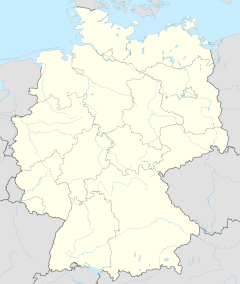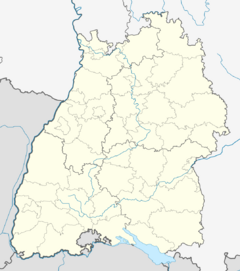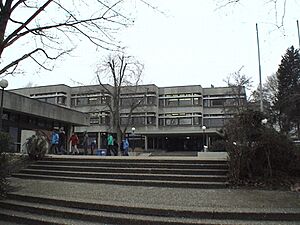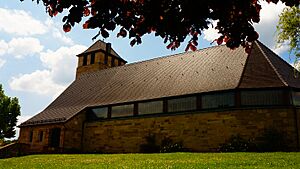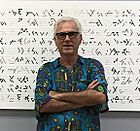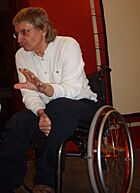Pforzheim facts for kids
Quick facts for kids
Pforzheim
|
|||
|---|---|---|---|
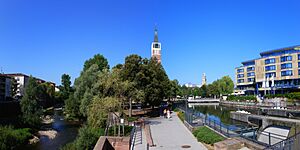 |
|||
|
|||
| Country | Germany | ||
| State | Baden-Württemberg | ||
| Admin. region | Karlsruhe | ||
| District | Stadtkreis | ||
| Subdivisions | 16 Stadtteile | ||
| Area | |||
| • Total | 98.03 km2 (37.85 sq mi) | ||
| Elevation | 273 m (896 ft) | ||
| Population
(2022-12-31)
|
|||
| • Total | 127,849 | ||
| • Density | 1,304.18/km2 (3,377.82/sq mi) | ||
| Time zone | UTC+01:00 (CET) | ||
| • Summer (DST) | UTC+02:00 (CEST) | ||
| Postal codes |
75172–75181
|
||
| Dialling codes | 07231, 07234, 07041 | ||
| Vehicle registration | PF | ||
| Website | www.pforzheim.de | ||
Pforzheim is a city in the southwest of Germany, located in the state of Baden-Württemberg. More than 125,000 people live here.
Pforzheim is famous for making jewelry and watches. Because of this, it's often called "Goldstadt," which means "Golden City." The city covers about 97.8 square kilometers. It sits between the big cities of Stuttgart and Karlsruhe. Three rivers meet here: the Enz, Nagold, and Würm.
Pforzheim is a special kind of city called a Stadtkreis. This means it's both a city and its own district at the same time. It also has the main offices for the Enz district, which is the area around the city.
During World War II, Pforzheim was bombed several times by the Allies. The biggest attack happened on February 23, 1945, by the Royal Air Force. This raid caused a lot of damage. About 17,600 people, which was nearly one-third of the city's population, lost their lives. Around 83% of the buildings were destroyed. The Allies believed Pforzheim was making special tools for the German war effort. They also thought it was a key place for moving German troops.
After the war, Pforzheim was managed by the United States military for a few years. Over the next 20 years, the city was slowly rebuilt. Today, many buildings in Pforzheim show the style of the time after the war, especially from the 1950s.
Contents
Geography
Pforzheim is located at the edge of the northern Black Forest and the hilly Kraichgau region. It lies in a valley where the Würm, Nagold, and Enz rivers meet. Because of its location, Pforzheim is often called the "three-valleys town" or the "Gateway to the Black Forest."
Pforzheim is an important regional center for many nearby towns and communities. These include places like Birkenfeld (Enz), Eisingen, and Remchingen.
Neighbouring Communities
Pforzheim shares borders with several towns and communities. Most of these are part of the Enz district. One exception is Unterreichenbach, which is in the Calw district.
City Wards
Pforzheim is divided into 16 city wards. Some of these, like Büchenbronn and Eutingen, used to be separate towns. They joined Pforzheim's administration in the 1970s. These communities have their own local councils. These councils share their ideas on important matters. However, the main Pforzheim city council makes the final decisions.
Here are the city wards:
- City center (Innenstadt)
- Northern ward (Nordstadt)
- Eastern ward (Oststadt)
- Southeastern ward (Südoststadt)
- Southwestern ward (Südweststadt)
- Western ward (Weststadt)
- Arlinger
- Brötzingen
- Buckenberg and Hagenschieß (including Altgefäll, Haidach and Wald-Siedlung)
- Büchenbronn (including Sonnenberg)
- Sonnenhof
- Dillweißenstein
- Eutingen an der Enz (including Mäuerach)
- Hohenwart
- Huchenfeld
- Würm
Climate
| Climate data for Pforzheim | |||||||||||||
|---|---|---|---|---|---|---|---|---|---|---|---|---|---|
| Month | Jan | Feb | Mar | Apr | May | Jun | Jul | Aug | Sep | Oct | Nov | Dec | Year |
| Mean daily maximum °C (°F) | 2.9 (37.2) |
5 (41) |
9.4 (48.9) |
13.9 (57.0) |
18.4 (65.1) |
21.5 (70.7) |
23.8 (74.8) |
23.4 (74.1) |
20 (68) |
14.3 (57.7) |
7.8 (46.0) |
4 (39) |
13.7 (56.6) |
| Mean daily minimum °C (°F) | −2.5 (27.5) |
−1.6 (29.1) |
0.8 (33.4) |
4 (39) |
8 (46) |
11.3 (52.3) |
13 (55) |
12.7 (54.9) |
9.6 (49.3) |
5.8 (42.4) |
1.5 (34.7) |
−1.4 (29.5) |
5.1 (41.1) |
| Average rainfall mm (inches) | 53 (2.1) |
49 (1.9) |
50 (2.0) |
60 (2.4) |
81 (3.2) |
94 (3.7) |
74 (2.9) |
78 (3.1) |
57 (2.2) |
54 (2.1) |
60 (2.4) |
60 (2.4) |
770 (30.4) |
| Average snowfall cm (inches) | 7.4 (2.9) |
4.5 (1.8) |
2.2 (0.9) |
0.7 (0.3) |
0.0 (0.0) |
0.0 (0.0) |
0.0 (0.0) |
0.0 (0.0) |
0.0 (0.0) |
0.4 (0.2) |
1.5 (0.6) |
5.7 (2.2) |
22.4 (8.9) |
| Average rainy days | 11.9 | 9.7 | 13.2 | 12.8 | 18.3 | 16.6 | 15.7 | 14.8 | 10.5 | 11.7 | 10.9 | 14.3 | 160.4 |
| Average snowy days | 8.8 | 7.3 | 3.4 | 0.6 | 0 | 0 | 0 | 0 | 0 | 0.2 | 2.3 | 5.9 | 28.5 |
| Mean monthly sunshine hours | 58.9 | 87.6 | 133.3 | 171 | 217 | 228 | 254.2 | 232.5 | 183 | 127.1 | 72 | 55.8 | 1,820.4 |
| Mean daily sunshine hours | 1.9 | 3.1 | 4.3 | 5.7 | 7 | 7.6 | 8.2 | 7.5 | 6.1 | 4.1 | 2.4 | 1.8 | 5.0 |
| Mean daily daylight hours | 8.8 | 10.2 | 11.9 | 13.7 | 15.3 | 16.1 | 15.7 | 14.3 | 12.6 | 10.8 | 9.2 | 8.3 | 12.2 |
| Source: Weather2visit, Weather Atlas | |||||||||||||
History
Pforzheim was settled by the Romans even before Stuttgart and Karlsruhe. Roman colonists built a crossing over the Enz river for their military road. This important location later made Pforzheim a center for the timber-rafting trade. Wood from the Black Forest was floated down rivers to places like the Netherlands.
Early Settlements and Growth
Around 90 AD, Roman citizens started a settlement near the Enz River. This place was called Portus, meaning "river crossing" or "harbor." This name is likely where "Pforzheim" comes from. In 259/260 AD, the Roman settlement was destroyed by the Frank and Alemanni tribes. For a long time after that, there were no written records about the settlement.
Graves from the 6th and 7th centuries show that people continued to live there. In 1067, Pforzheim was first mentioned in a document by Henry IV, Holy Roman Emperor. The "old town" of Pforzheim gained market rights before 1080.
Around 1150, a "new town" was built. In 1220, the Margraves of Baden chose Pforzheim as their home. This made the new town very important. By the 13th and 14th centuries, Pforzheim was thriving. It earned money from wood, leather, and textile trades. The town also had walls built around it by 1290.
15th Century Developments
In the 15th century, various groups called fraternities were formed. These were like early forms of insurance, helping members with things like sickness or funerals. For example, tailors, bakers, and weavers had their own fraternities.
In 1447, a big wedding was held in Pforzheim. Margrave Charles I of Baden married Katharina of Austria, the sister of Frederick III, Holy Roman Emperor.
In 1455, Johannes Reuchlin, a famous German thinker, was born in Pforzheim. He went to the Latin School here, which became a very important school. Many famous students, including Reuchlin's nephew Philipp Melanchthon, studied there.
In 1496, the first printing shop was set up by Thomas Anshelm. Pforzheim's printers helped spread new ideas in the early 16th century.
16th Century Changes
In 1501, a rule was made for the timber rafting business in Pforzheim. Logs from the Black Forest were tied together here to make big rafts. These rafts then floated down rivers to other places.
The 1520s saw the quick spread of Protestantism in Pforzheim. In 1535, Margrave Ernst of Baden made Pforzheim his family's home. However, in 1565, Margrave Karl II moved the family's main residence to Durlach. Pforzheim remained an important administrative center.
17th Century Conflicts
In 1618, at the start of the Thirty Years' War, Pforzheim had about 2,500 to 3,000 people. The "old town" was burned down by Bavarian troops in 1645. It was rebuilt but lost its strong defenses.
From 1688 to 1697, the "War of the Palatinian Succession" caused huge destruction in southwest Germany. French troops occupied Pforzheim in 1688. They forced the town to pay money and house soldiers. In 1689, the French set many buildings on fire, destroying about a quarter of the houses.
Later that year, French troops returned and shelled the town. Pforzheim was forced to surrender, and the inner town was set on fire. The French returned again in 1691 and 1692, causing more damage. They looted the town, stole church bells, and burned down houses that had survived earlier attacks. The town's archives were also destroyed. After these attacks, Pforzheim was left in a very bad state.
18th Century Beginnings
In 1718, an institution for orphans and the sick was opened. About 50 years later, in 1767, this institution started a watch and jewelry factory. This was the beginning of Pforzheim's famous jewelry industry.
19th Century Innovations
In 1809, Pforzheim's administrative areas were reorganized. In 1836, Ferdinand Öchsle invented a device in Pforzheim to measure sugar in grape juice. This device is still used today to check wine quality.
Pforzheim became connected to the German railway network in 1861-62. This helped the city grow. In 1869, the first workers' union was formed for gold craftsmen.
In 1888, Bertha Benz, the wife of car inventor Carl Benz, drove through Pforzheim. This was the first "long-distance" car trip in history. She even bought gasoline from a pharmacy in Pforzheim! Today, the Bertha Benz Memorial Route lets people follow her historic journey.
20th Century and World War II
The Pforzheim watchmaking industry became popular again in the 1900s. In 1905, the Brötzingen area became part of Pforzheim.
From 1933, the Nazi government took control in Germany. Jewish citizens in Pforzheim faced persecution. In 1938, the Pforzheim Synagogue was badly damaged during the Kristallnacht and later torn down. In 1940, Jewish citizens from Pforzheim were sent to a concentration camp in France.
World War II Bombing
By 1944, many factories in Pforzheim were making weapons for the war. On February 23, 1945, the Royal Air Force carried out a massive bombing raid. Over 17,000 people died, and about 83% of the city's buildings were destroyed. The Allies believed Pforzheim was important for making precision instruments and moving German troops.
After the main attack, about 30,000 people needed help with food because their homes were gone. Many people were buried in mass graves. Almost 90% of buildings in the city center were destroyed.
Post-World War II Rebuilding
From 1945 to 1965, Pforzheim was rebuilt. This gave the city a modern look. Many bridges were repaired or rebuilt during this time.
In 1968, a rare tornado hit Pforzheim. It caused a lot of damage to buildings and forests. French and US soldiers helped clear the streets.
Between 1971 and 1975, several nearby towns joined the Pforzheim city administration. In 1975, Pforzheim's population went over 100,000, making it a "large city."
21st Century Discoveries
In 2002, during construction work, a 250 kg bomb from 1945 was found. About 5,000 people had to leave their homes while specialists safely removed the bomb.
Demographics
Administrative Unions
Here are the areas that became part of Pforzheim over time:
| Date incorporated | Community | Increase in km2 | Increase in sq mi |
|---|---|---|---|
| 1 January 1905 | Brötzingen | 13.01 | 5.02 |
| 1 January 1913 | Dillweißenstein | 4.612 | 1.781 |
| 1 April 1924 | Parts of Haidach district | 0.76 | 0.29 |
| 1 October 1929 | Parts of Hagenschieß district | 16.23 | 6.27 |
| 1 September 1971 | Würm | 8.22 | 3.17 |
| 1 April 1972 | Hohenwart | 4.92 | 1.90 |
| 1 January 1974 | Büchenbronn | 11.14 | 4.30 |
| 1 January 1975 | Huchenfeld | 9.47 | 3.66 |
| 20 September 1975 | Eutingen an der Enz | 8.45 | 3.26 |
Population Growth
The number of people living in Pforzheim has changed a lot over the centuries.
| Historical population | ||||||||||||||||||||||||||||||||||||||||||||||||||||||||||||||||||||||||||||||||||||||||
|---|---|---|---|---|---|---|---|---|---|---|---|---|---|---|---|---|---|---|---|---|---|---|---|---|---|---|---|---|---|---|---|---|---|---|---|---|---|---|---|---|---|---|---|---|---|---|---|---|---|---|---|---|---|---|---|---|---|---|---|---|---|---|---|---|---|---|---|---|---|---|---|---|---|---|---|---|---|---|---|---|---|---|---|---|---|---|---|---|
|
|
|||||||||||||||||||||||||||||||||||||||||||||||||||||||||||||||||||||||||||||||||||||||
The city's population grew a lot between 1830 and 1925, during Germany's industrial growth. It dropped sharply after the 1945 bombing. Then, it grew quickly again as the city was rebuilt.
Immigration
Pforzheim is home to people from many different countries. Here are some of the largest groups as of 2018:
| 4,952 | |
| 4,129 | |
| 3,939 | |
| 3,653 | |
| 2,173 | |
| 1,735 | |
| 1,392 | |
| 1,062 | |
| 993 | |
| 895 | |
| 845 | |
| 754 | |
| 710 | |
| 691 | |
| 397 | |
| 332 | |
| 322 | |
| 278 | |
| 242 | |
| 212 |
Religions
For many centuries, Pforzheim was mainly a Protestant town. This was after Margrave Karl II of Baden introduced the Protestant Reformation in 1556.
Since the 1800s, Catholics have also settled in Pforzheim. Today, there are also other religious groups in the city. These include Jewish, Islamic, Adventist, and Baptist congregations.
Economy and Infrastructure
Pforzheim is a major economic center in Baden-Württemberg. It has a high number of industries for its size.
Pforzheim is famous for its jewelry and watch-making. This is why it's called the "Golden City." The jewelry industry started here thanks to Jean François Autran. Pforzheim makes almost 70% of Germany's jewelry and silverware. It also exports about 80% of Germany's jewelry.
Today, Pforzheim's economy is also strong in other areas. These include metal processing, dental products, and electronics. Big mail-order companies like Bader and Klingel are also based here. Tourism is also growing. Pforzheim is a great starting point for hiking, cycling, and river trips. It's also on the European long-distance trail E1.
Transport
Pforzheim is an important railway hub. It's on the main line between Karlsruhe and Stuttgart. Two branch lines to the Black Forest also start here: the Enz Valley Railway and the Nagold Valley Railway.
Since the 1990s, the Karlsruhe tram-train system reaches Pforzheim. You can take the S5 tram-train directly into Karlsruhe city center. The S6 tram-train connects Pforzheim with Bad Wildbad. Regional trains also link Pforzheim to other major cities like Stuttgart and Tübingen. Some Intercity trains also stop here.
Local buses run on 13 routes within Pforzheim. There are also regional bus services to nearby towns. All public transport in Pforzheim and the surrounding area uses a single ticket system.
The A8 Autobahn runs just north of the city. Pforzheim has four exits on this highway. Other important roads like the B10 and B294 also pass through the city.
Major Local Businesses
- Wellendorff Gold-Creationen GmbH & Co. KG: A family-owned jewelry company since 1893.
- Victor Mayer GmbH & Co. KG: A company that makes jewelry.
- Amazon: Has a logistics center here.
- Durowe: A company that makes watch movements.
- Klingel Mail Order Company: A large mail-order business.
- Bader Mail Order Company: Another large mail-order business.
- Wenz Mail Order Company: Another large mail-order business.
- Witzenmann GmbH: Makes special metal products.
- Thales: An electronics company.
- Sparkasse Pforzheim Calw: A local financial services company.
Media
Pforzheim has two daily newspapers: Pforzheimer Zeitung and Pforzheimer Kurier.
Courts of Justice
Pforzheim has a Local Court of Justice. It also has a local labor court.
Public Authorities
Pforzheim is home to several important public offices:
- Pforzheim Employment Exchange: A federal government agency.
- Pforzheim Internal Revenue Agency: A state agency.
- Northern Black Forest Chamber of Commerce: Represents businesses in the region.
Educational Institutions
- Pforzheim University of Applied Sciences: This university has about 5,400 students. It offers programs in design, technology, and business. It was formed in 1992 by combining older schools. The university has strong international connections.
- The Goldsmith and Watchmaking Vocational School: This is one of only two such schools in Europe. Many students from other countries come here to study.
- Pforzheim has several high schools where students can prepare for university. These include Reuchlin-Highschool and Kepler-Highschool.
- There are also many schools for elementary and secondary education. Adults can also take classes at the Volkshochschule.
Culture and Places of Interest
Theatre
- Municipal Theatre of Pforzheim: Here you can see opera, dance, musicals, and plays.
Orchestras
- Pforzheim Chamber Orchestra: This orchestra was started in 1950. It is well-known beyond the region.
- Symphony Orchestra of the City of Pforzheim.
Museums
- Archeological Site Kappelhof: Shows Roman and medieval items found during digs.
- The Pforzheim Jewellery Museum: Located in the Reuchlinhaus, it displays beautiful jewelry.
- The Pforzheim City Museum: Learn about the city's history here.
- The Technical Museum of the Jewellery and Watchmaking Industry: Shows how jewelry and watches are made.
- Roman Estate in the Kanzlerwald: You can see the remains of a Roman settlement here.
Cultural Institutions
- The House of Culture Osterfeld: A center for theater, music, dance, and art.
- Kupferdaechle: A cultural center for teenagers.
- The Communal Cinema of Pforzheim: A place to watch movies.
- CongressCenter Pforzheim (CCP): A large venue for events.
- City Library: A place to read and borrow books.
Notable Architecture
Pre-war Buildings
- The Archive Building
- The House of Industry
- The Arch Bridge at Dillweißenstein
- The ruins of Liebeneck Castle
- The Old Grapes Press of Brötzingen
Post-war Buildings
- The Main Railway Station
- Reuchlinhaus
- The Old and New City Hall
- Churches:
- The Palais and Monastery Church St. Michael: This church is a symbol of the city.
- Resurrection Church (Auferstehungskirche): A Protestant church.
- The Bare Feet Church (Barfüsserkirche): A Catholic church.
- The Protestant City Church (Stadtkirche)
- Sacred Heart Church (Herz-Jesu-Kirche): A Catholic church.
- St. Matthew Church (Matthäuskirche): This church was designed by a famous architect.
Twin Towns and Sister Cities
Pforzheim has special partnerships with other cities around the world. These are called twin towns or sister cities:
 Gernika-Lumo, Spain (1989)
Gernika-Lumo, Spain (1989) Saint-Maur-des-Fossés, France (1989)
Saint-Maur-des-Fossés, France (1989) Vicenza, Italy (1991)
Vicenza, Italy (1991) Irkutsk, Russia (2007)
Irkutsk, Russia (2007) Nevşehir, Turkey (2007)
Nevşehir, Turkey (2007) Częstochowa, Poland (2007)
Częstochowa, Poland (2007) Győr-Moson-Sopron, Hungary (2007)
Győr-Moson-Sopron, Hungary (2007) Osijek, Croatia (2008)
Osijek, Croatia (2008)
Notable People

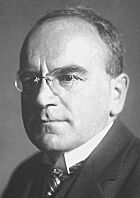
Many interesting people were born or lived in Pforzheim:
- Johannes Reuchlin (1455–1522): A famous thinker and philosopher.
- Bertha Benz (1849–1944): The wife of car inventor Carl Benz, known for the first long-distance car trip.
- Heinrich Otto Wieland (1877–1957): A chemist who won the Nobel Prize in 1927.
- Manfred Mohr (born 1938): An artist who is a pioneer in digital art.
- Jochen Hasenmayer (born 1941): A famous cave diver.
- Dieter Kosslick (born 1948): The director of the Berlinale Film Festival.
- Stefan Mappus (born 1966): A politician.
Sports Personalities
- Nicola Thost (born 1977): A snowboarder who won a gold medal at the 1998 Winter Olympics.
- Vincenzo Grifo (born 1993): A footballer.
- Robin Hack (born 1998): A footballer.
Images for kids
See also
 In Spanish: Pforzheim para niños
In Spanish: Pforzheim para niños




